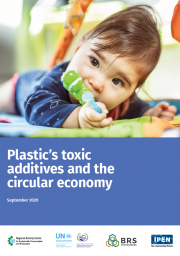

Subscribe to SCP News
Toxic Additives in Plastics: Hidden Hazards Linked to Common Plastic Products

Toxic chemicals of concern that are widespread in common plastic products can hinder the momentum for a circular economy. A new report, coordinated by the Barcelona-based(1) Regional Activity Centre for Sustainable Consumption and Production (SCP/RAC), serving both the Stockholm Convention and the Barcelona Convention, has been produced in collaboration with the International Pollutants Elimination Network (IPEN) in order to shine a light on extensive evidence of toxic chemical components in plastics that can harm human and environmental health and impede a safe circular economy.
Download the publication here in English | French | Spanish | Arabic
” Plastic’s Toxic Additives and the Circular Economy” references vast evidence from renowned scientific articles and journals on the most concerning groups of chemicals used in plastic production. The report identifies “substances of concern” in plastics that pose a risk to human and environmental healthincluding flame retardants, perfluorinated chemicals, phthalates, bisphenols, and nonylphenols. These substances, many of which are endocrine disrupting chemicals, are toxic additives in plastics that are commonly used in everyday consumer goods including: children’s toys, food packaging, electronics, as well as textiles, upholstery, and furniture.
The report covers the presence and impact of the hazardous chemicals of concern in all stages of plastic product use-cycle from production and use, to recycling and landfill, incineration, waste to energy, and land and marine accumulation, and addresses their associated impacts on human, marine biota, and environmental health.
Human health consequences of endocrine disrupting chemicals commonly used in plastics include thyroid function disruption, reproductive impacts, obesity, immune system, increased damage, increased cancer risk and impacts on brain and neurological development.Toxic additives also affect marine life which is particularly worrying in the Mediterranean Region, considered a biodiversity hotspot.
"The COVID-19 pandemic has illustrated the links between environmental health and the wellbeing of human societies. Now is the time to act on science to reduce plastics' toxic chemical additives and the pollution in all its forms and to seek sustainable ways in which we can live in harmony with nature. Taming the leviathan of plastic litter, which stifles marine life and releases highly hazardous substances in the environment, must become a priority,” Gaetano Leone, Coordinator of UNEP/MAP—Barcelona Convention Secretariat said. There are many steps that can be taken to recover in a smart way from COVID-19. Tackling the plastic pandemic is a giant step towards a green renaissance in Mare Nostrum, Mr. Leone observed.
Circular economy models are designed to eliminate waste, rebuild natural capital and keep products, materials and molecules flowing effectively through the economy at their highest value. Based on this approach, plastics that contain hazardous chemicals can continually expose ecosystems and people to harmful agents. This is of particular concern with recycled plastics that contain POPs (Persistent Organic Pollutants), which are banned or regulated in international chemical conventions, including the Stockholm Convention.
Rolph Payet, BRS Secretariat Executive Secretary, stated: ‘There are a wide variety of chemical additives in plastics, some of them have been identified as Persistent Organic Pollutants (POPs) and are now listed under the Stockholm Convention – for example, brominated flame retardants and fluorinated water repellents. However, it is challenging for countries to manage POPs and other hazardous chemicals added to plastics throughout their life cycle including when plastic wastes are finally disposed of or recycled". We also need transparency on which plastics contains which additives, to enable their subsequent environmentally sound management. I urge industry and academia to intensify their efforts to find alternatives to such additives in plastics.””. Efforts to tackle the world’s plastic pollution problem must further address the substances of concern that are ubiquitous in plastic waste.
Polymers and their additives are extensively used in consumer products to make synthetic fibres, foams, coatings, adhesives and sealants. “Recycled plastics” – plastics from a variety of sources that have been melted down, re-formed, and used to make new products have been shown to contain many banned, restricted, or otherwise hazardous chemicals.
The publication details toxic exposures related to each state of the plastic life cycle from production to disposal addressing landfill and incineration. Emissions of hazardous substances such dioxin are a result of uncontrolled combustion of plastic waste and, in particular of plastics containing halogens such as PVC, polytetrafluorethylene, Teflon, or brominated flame retardants. Technologies such as pyrolysis or combustion of fluorinated polymers or fluoropolymer dispersion can result in the unintentional formation and release of fluorinated POPs (e.g. PFOA), other PFAS, other toxic substances, ozone depleting substances and greenhouse gases. The publication details how air pollution control in incineration technologies result in highly toxic dioxin intensive incinerator ash.
SCP/RAC’s director, Enrique de Villamore highlighted - ‘Building on the momentum the frontrunners have created regarding the plastic waste global crisis, we need to increase our ambition and to go ‘beyond recycling’ to address plastic pollution at source with a solid prevention strategies, e.g. ’Accelerating safer material innovation, promoting industry collaboration, innovating in recycling systems and ensuring transparency throughout the value chain. SCP/RAC will continue to push the boundaries and support ambitious objectives for a safe circular economy in the coming years.
In order to tackle the issue, the report call for coordinated strategies to reduce the production and use of chemicals of concern and prevent regrettable substitutions in plastic products. Four key approaches to tackle the challenges that hazardous chemical additives pose to achieving a circular economy are identified:
- Materials should be designed in accordance with goals of causing no harm to environmental and human health and achieving zero waste
- Investment must be made to develop new, safer materials and systems that avoid the production and use of plastics with hazardous chemical additives and the replacement of toxic additives with regrettable substitutions
- Industry collaboration will be key for industry to take responsibility for the hazardous materials they produce
- Transparent chemical composition labelling of plastic materials need to be promoted
“This report is important as it illustrates hazardous chemical additives linked threats to human health and the environment. In order to ensure a non-toxic circular economy, we must ensure a precautionary approach throughout the entire lifecycle of plastics," said Dr. Sara Brosché, International Pollutants Elimination Network (IPEN)
-----------------------------------
Originally released as an Information Document to Delegates for the 2019 Conference of the Parties to the Basel and Stockholm Conventions by the Regional Activity Centre for Sustainable Consumption and Production (SCP/RAC), regional centre of both the Stockholm Convention on Persistent Organic Pollutants (SCRC-Spain) and the Barcelona Convention for the Protection of the Marine Environment and the Coastal Region of the MediterraneanSCP/RAC, the report was developed with the active involvement of other regional centres of the Basel and Stockholm Conventions, international organisations and experts that joined the Marine Litter Topic Group.
[1]
SCP/RAC is a Regional activity centre of both the Stockholm Convention on Persistent Organic Pollutants and the Barcelona Convention for the Protection of the Marine Environment and the Coastal Region of the Mediterranean.














